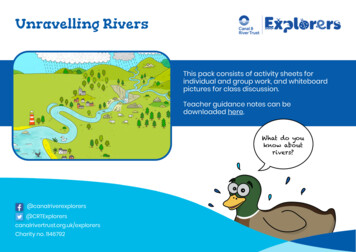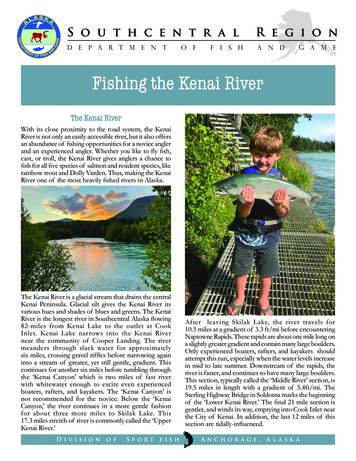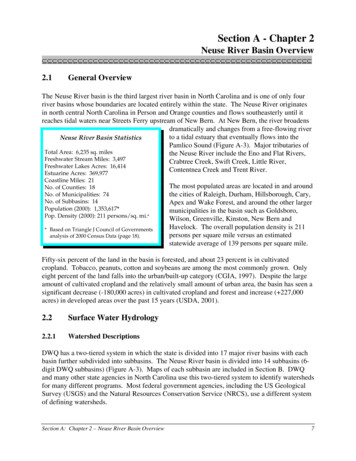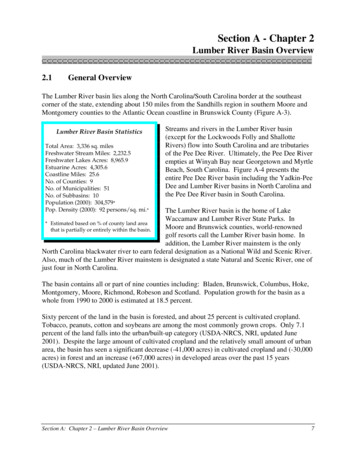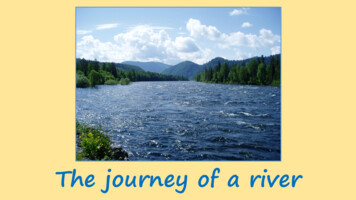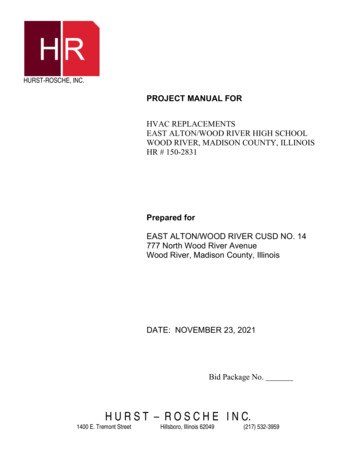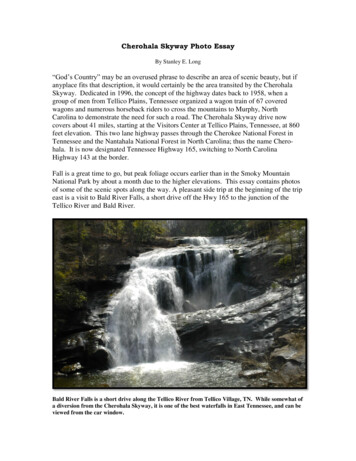
Transcription
An Ooligan Teacher’s GuideRicochet Riverby Robin CodyGenres: Young Adult, Historical FictionGrade Level: 9th–12thTopics: Coming of Age Friendship Native American Culture Pacific Northwest Fishing andLogging Industry Intergenerational/Intercultural/Interclass Relationships
Ricochet RiverTeacher’s GuideRicochet Riverby Robin CodyBook DescriptionDraw students into the diverse yet interconnected lives of three teenagers in thefictional small town of Calamus, Oregon. A recipient of the Oregon Book Award,Ricochet River, set in the 1960s, explores what it means to grow up—with Wade, thelocal sports hero; his friend, Jesse, a Native American with an innocent disregard forlocal convention; and Lorna, Wade’s sweetheart, who longs to break free of her smalltown ties and set out into the world beyond.A contemporary companion to J. D. Salinger’s classic, The Catcher in the Rye, this novelencourages students to discover that the thoughts and dreams of fictional characterscan closely resemble their own.About the AuthorRobin Cody is a freelance writer of both fiction and nonfiction. He is a winner of theWestern Writers of America Silver Spur Award for short nonfiction. In 1995, he wonthe Oregon Book Award for Voyage of a Summer Sun, an account of his canoe trip fromthe headwaters of the Columbia to its mouth at the Pacific. In 2005, Ricochet River wasselected as one of top one hundred literary works produced in Oregon in the last twohundred years. Mr. Cody lives in Portland, Oregon, with his wife Donna.Introduction: Celilo FallsCelilo Falls (or Wyam, meaning “echo of falling water”) was once the sixth largestwaterfall by volume in the world. Located east of the Cascade Mountains on theColumbia River (the waterway that separates Oregon and Washington), the falls wereprimarily used by Native Americans for salmon fishing. For 15,000 years, tribes such asthe Yakama, Umatilla, Warm Springs, and Nez Perce congregated around the majesticfalls to catch salmon from wooden platforms with dip nets and spears. Celilo was alsoa thriving trading post and attracted Native Americans from as far away as the GreatPlains and Alaska. Some historians have even called Celilo the “Wall Street of the West.”1
Ricochet RiverTeacher’s GuideRicochet Riverby Robin CodyThe arrival of settlers in the 1800s brought about great change. Since many of themlost their lives navigating up the Columbia River, the Army Corps of Engineering built afourteen mile long portage around the falls in 1915. By 1940, with the arrival of manymore settlers, civic leaders proposed a plan for a dam that would improve navigation,provide hydroelectric power to the area, accommodate farmland with irrigationsystems, and prevent the flooding of cities downriver. It was an idea that satisfiedmany settlers, but it was devastating to the original inhabitants of the land.With the proposed dam looming, tribes continued to catch salmon in Celilo under the1855 Treaties that guaranteed their ancient right to fish the area. A 1947 governmenthearing, however, dictated that the dam was not in violation of tribal fishing rights,and building commenced. A monetary settlement of 26.8 million was reached andwas to be paid to the affected tribes for the loss of their fishing grounds. They neverreceived the money. Today a small community of about one hundred people stillresides in nearby Celilo Village. It is on a bluff that overlooks what was formerly themajestic waterfall. Although they still fish there, the rush of the falls remains a distantmemory for the tribes that once called Celilo home.Robin Cody’s Ricochet River provides access to this piece of history, blended withthe coming-of-age story of three youths affected by its outcome. As a generaltextual discussion strategy, this lesson guide is meant to engage students with thetext and its themes, allowing them to pursue a connection within their own lives,whether in relation to characters from the book, or in discovering the origins of theirown ancestors, as Jesse has done in Ricochet River. This guide is not meant to becomprehensive, and should be used to supplement classroom material already inplace. Please feel free to adapt or alter this lesson to better meet the needs of eachclassroom.2
Ricochet RiverTeacher’s GuideChapter-by-Chapter Summary and AnalysisLesson Plan by: Katie Grone (Introduction and Chapters 1–5), Ian Ogden (Chapters 12–17),Kayla Price (Chapters 6–11), Jesse Wray (Chapters 18–25)Grade Level: 9th–12thOregon State Standards:Estimated Time: Twelve class periods.EL.08.RE.17 Identify and/or summarize sequenceof events, main ideas, facts, supporting details,and opinions in informational and practicalselections.Materials Needed: One copy of Ricochet River for each student. Discussion sheets for each student toprepare a short chapter summary, writedown quotes that they found important,answer prompted questions, and analyzeimportant themes for the week’s chapterassignments.Background Knowledge Needed: Studentswill have performed a close reading of thenovel, Ricochet River, as per each week’s chapterassignments.Purpose: To develop skills in critical thinking andliterary analysis through class discussion, thesis writing,and a close reading of the text.Procedure: Three class sessions per week will beallotted over the course of four weeks to meet anddiscuss the twenty-five chapters of Ricochet River.Week one: Students will read and prepare discussionsheets for chapters one through five.EL.08.RE.22 Determine the author’s purpose andperspective and relate them to specific details inthe text.EL.08.LI.12 Analyze the importance of the setting(place, time, customs) to the mood, tone, andmeaning of the text.EL.08.WR.25 Write responses to the literature;demonstrate careful reading and insight intointerpretations; support interpretations throughreferences to the text, other works, other authors,or to personal knowledge; draw supportedinferences about the effects of a literary work onits audience.EL.08.WR.27 Write persuasive compositions;include a well-defined thesis that makes a clearand knowledgeable judgment or appeal; presentdetailed evidence, examples, and reasoning tosupport arguments, differentiating between factsand opinions.Week two: Students will read and prepare discussionsheets for chapters six through eleven.Week three: Students will read and prepare discussionsheets for chapters twelve through seventeen.Week four: Students will read and prepare discussionsheets for chapters eighteen through twenty-five.Assessment: Weekly discussion sheets will be gradedon a complete/incomplete scale. Students will alsocomplete a five to six page thesis-style paper regardingthe characters, the plot, thematic elements, or thesetting of Ricochet River, to be due at the end of weekfive of this unit.3
Chapter OneSummary:The novel opens with a conversation about déjà vu between Wade and Jesse as they are rowing down the river. Wadeexplains the meaning of déjà vu; Jesse explains its inverse, “vuja de.”Wade begins his story by narrating his first encounter with Jesse at baseball practice. Arriving at the field, he seesJesse, a Native American boy, on the pitching mound hurling strikes and wonders who he is. Coach Palermo, gettingpractice started, tells Jesse to “throw right,” meaning throw easier, because he is pitching too fast for batting practice.Jesse, who has been pitching left-handed until that point, misinterprets him, and impresses everyone by throwingright-handed with equal facility.After practice, Wade, and a few teammates head to the barbershop and café where Lorna, Wade’s girlfriend, waitstables. They discuss their new teammate, Jesse. Wade is curious if an Indian would have a birth certificate. Jesse showsup, uninvited, and joins them. As they speak for the first time, Jesse tells them he is a Klamath Indian from Celilo. WhenLorna takes their order, Jesse makes a joking remark about her attractiveness, and although he means no harm, Wadeis infuriated. Getting up to fight, Wade throws a wild punch at Jesse who catches his fist, causing Wade to fall. Theloggers at the shop mistakenly see this as an attack on Wade and kick Jesse out.Important Quotations:“Another thing about the Entering Calamus sign. There’s only one. The only Entering Calamus sign is where you comeinto town from Portland.” (13)“Anyway, the topic in our booth, of course, was the Indian. We’d seen he could hit too, and he had that dark gift ofspeed. But more than that he had a way of carrying himself, or just being there—him and his eerie grin—as if hebelonged.” (15)“‘Peace,’ said Jesse. He stuck out his hand. ‘Peace,’ I said. I mean, what do you say? Like I should have doffed my cavalryhat, set my Winchester aside? I shook his hand, which was leathery and warm, with long fingers. There was thiscrooked grin about him, like now I should explain what we were doing here.” (16)Discussion Questions:1. The book opens with Wade and Jesse floating down the river on a boat, a scene in which some importantinformation can be inferred about our two main characters. Based on this opening conversation, what can beinferred about Wade? About Jesse?2. Discuss the social dynamic between Jesse and the townspeople in Calamus. Is he an “insider” or an “outsider”? Whatspecific evidence supports your argument?3. How do the loggers react to Wade’s attempt to punch Jesse in the barbershop? What does this suggest about thetownspeople?Themes/Analysis:The opening chapter of the novel reveals Wade’s first impressions of Jesse, someone who is ironically seen as an“outsider,” now living in the area his ancestors were forced away from. Jesse tries to overcome Native Americanstereotypes by playing into them, making jokes about himself and his heritage in an effort to fit in with the boys hisage. It is clear that in Calamus, things are done by unspoken rules and tradition, which will be an obstacle for Jesse.4
Chapter TwoSummary:Wade recounts Jesse’s story of Coyote, a Klamath Indian trickster figure who is always goofing up and makingmistakes. In the story, Coyote mistakes cattails swaying in the wind at night for dancers and joins them, thinking theywould be happy that he showed up to entertain them.Wade resumes his own story, picking up at the barbershop on Friday night following the fight with Jesse (about whichthe local loggers have been gossiping). Wade finds out that Jesse’s mother, Reno, is from Celilo and has a questionablepast. The loggers also discuss the money that the Celilo inhabitants received from the government for being displaced.The next day is the baseball game against West Linn. Everyone in town comes to watch, including Wade’s father,Duncan, who honchos the field, and Link, his grandfather, who sits among the loggers superstitiously eating honey.Wade is surprised that Coach Palermo starts Jesse on the mound and himself at shortstop. At bat, Wade hits asingle. Jesse is up next and gets a solid hit, which drives Wade around third. Heading toward home plate, Wade getsclobbered from behind: Jesse ran so fast he caught up to Wade. At the barbershop, the locals tell the story again andagain, impressed with Jesse’s athletic ability, which earns him some respect in Calamus.Important Quotations:“Celilo Falls is over on the Columbia River, by The Dalles. It is—it was—a big fishing place. The Indians netted salmonfrom the rocks. I’d seen it, before they put in the big dam. Now Celilo is a wide, silent lake where the village used to be.They moved the Indians out, I guess. I’d never thought about where the Indians went.” (20)“Duncan works in Portland, but he grew up in Calamus. He used to log, before he went to college, so folks don’t holdcollege against him.” (22)“I guess sometimes—at least at the barbershop—reality has to adjust to the story.” (27)Discussion Questions:1. In the beginning of Chapter Two, Wade recounts Jesse’s story of Coyote, a Native American legend, and for a briefmoment the tense is switched. What is implied about Jesse and his relationship with Wade by this narration? Do youthink there is any other significance to this story?2. On page twenty, Wade mentions Celilo Falls, but does not go into great detail about the area’s history. Look up CeliloFalls on the Internet and consider Wade’s remark: “I’d never thought about where the Indians went.” Why might thiscomment be meaningful in regard to Jesse’s arrival to town?3. Robin Cody, through Wade’s narration, paints a very distinct picture of the townspeople at the baseball game and atthe barbershop. How are they characterized in this chapter? Use specific examples from the text.4. Wade mentions at the end of the chapter that “. sometimes—at least at the barbershop—reality has to adjust to thestory.” What does this mean, and what does it imply about the locals?Themes/Analysis:In Chapter Two, Wade characterizes the townspeople of Calamus in more depth. We see that the town is rooted intradition—the sentiment is that things have always been a certain way here, and that is the way they will always be.We also see that the people value local legends, stories, and gossip. When Jesse makes the incredible play on thebaseball field, he is automatically inducted into Calamus’s culture by way of legendary athleticism. As an outsider, thisis his ticket to possible inclusion in the small, exclusive town culture.5
Chapter ThreeSummary:Wade describes the landscape in and around Calamus—the woods, the reservoir, and the canyon that surrounds andruns through it. He notes the smell of smoke from the slash burner and the diesel fumes from the logging trucks asthey discard their loads into the millpond.On his way to Austin Hot Springs on an errand for his job at Northwest General Electric (NWG), Wade sees Jesse on theside of the road and picks him up. The two drive along the river road, Jesse investigating items in the truck and makingjokes. They stop at a spot along the river, split Wade’s lunch, and take a swim. Wade’s inquiry about Jesse’s father is metwith a vague reply. Jesse instead tells him about, “He-Who-Died, the last of the Dreamers,” who foresaw the flooding ofCelilo Falls. They play a baseball-like game with golf balls and a stick, and they lose track of time. They are late to makethe delivery to Austin Hot Springs, and Jesse makes up a story to excuse their tardiness.Important Quotations:“‘Austin Hot Springs doesn’t have a store?’ This information shook Jesse to the roots. ‘Why are we doing this?’ he said. ‘Ithought Austin Hot Springs was one of those resorts for fat white people. Eat fry bread and sit on hot rocks.’” (32)“‘He-Who-Died was the last of the Dreamers, I think,’ Jesse said. ‘Him and Lawrence White Fish. He dreamed the biglake over Celilo Falls before the dam went up, and he said it. When the dam went up, people saw what a great Dreamerhe was. So he didn’t have to work. He just grew his hair. That was all he did.’‘So this He-Who-Died, what did he die of?’‘The dam. Old age.’” (35)Discussion Questions:1. In Chapter Three, we learn more about Jesse through dialogue. Describe Jesse in terms of his conversation withWade and the references to his family and Native American folklore.2. Wade observes a crow and views it as a kind of sign: “It seemed like, you know, I mean if you were an Indian. youmight be kind of worried about a big black bird like that, so upset. But Jesse didn’t pay it any mind.”(35) What doesthis indicate about Jesse’s personal beliefs with regard to his Native American heritage? What about Wade’s take onNative American beliefs?Themes/Analysis:In Chapter Three, Wade and Jesse’s characters become more developed. We start to see funny, friendly, and wittyaspects of Jesse when he plays with the items in the truck and cracks jokes about himself. It also reveals an awarenessof how he is perceived by others. He is obviously defining himself as Native American, as he constantly refers to hisheritage. However, he also seems to contradict the stereotype—he is surprised and disappointed that Austin HotSprings does not have a store, he misinterprets Native American words, and he even wears a Cleveland Indians ballcap. Wade is becoming intrigued by his enigmatic new friend.6
Chapter FourSummary:Wade discusses his mother and her discomfort with the “West,” noticing the family silver, crystal, and close attentionto manners. It “makes her more East than West.” He describes her hobby of painting and mentions her inability toaccurately paint fir trees.Wade picks Lorna up from the barbershop, and she breaks into a rant about how much she dislikes Calamus, howsmall and gossipy the town is. Wade, who does not necessarily agree with her, cites the books she reads as the sourceof her bitterness. In an effort to calm her down, he offers to tell her a story (a strategy he uses often) and proceedsto tell her about a trip his family took down the Columbia River Gorge to Celilo Falls when he was a child. He vividlydescribes the huge waterfall, the activity of the Native Americans, and their modest dwellings.Important Quotations:“Maybe she’d be nervous even if she’d stayed Back East. What she brought to Calamus was some fine old family silverand crystal for special occasions. And a close attention to manners. Which makes her seem more East than West.” (37)“Mother and Duncan were ready to leave, but I was not. Duncan explained how only Indians could fish like this. Treatyrights. I was ready to cash in my citizenship, whatever it took. I’d never seen anything like this.” (42)“‘I don’t see how money would do it,’ she said. you try to think what would do it, and there isn’t anything. Once thefalls are gone, they’re gone. It’s not an easy thing to think about.” (43)Discussion Questions:1. What does Wade mean when he says that his mother’s close attention to manners, “makes her seem more East thanWest”? What might this have to do with her inability to paint fir trees?2. Why does Lorna feel the way she does about Calamus? Cite specific examples.3. When Lorna says, “I don’t see how money would do it,” what does she mean?4. Why does Lorna not like “true stories”? Why would the story of the raft mean so much to her?Themes/Analysis:The theme of East versus West is explored, as Wade characterizes his mother as more refined and cultured—representative of Eastern values. On the other end of the spectrum is the wildness and freedom of the West, whereWade seems to belong. We can plot each character along this continuum according to their values, behavior, andbeliefs. Lorna, who wants nothing to do with Calamus, wants to escape to school back East, far from the uncivilizedtownspeople; Wade, however, would prefer to set out even farther West. Robin Cody makes a very poignantcommentary on civilization versus nature with this symbolic representation of East and West, noting how the “civilized”Easterners overtook Celilo Falls and forced the Natives from their land.7
Chapter FiveSummary:Wade wants to cut down a fir tree from Link’s property to decorate as a Christmas tree. Link does not allow it. Instead,he makes Wade agree to find another tree from out in the forest and dig it up, as opposed to cutting it down. After twodays of digging the enormous roots, Wade finally gives up.Wade describes Link’s bunkhouse, which used to be part of Link’s father-in-law’s mill. This mill established the townof Calamus and had been fully operative until Northwest General Electric built the dam and created the lake. Thecompany allowed Link to occupy the bunkhouse after the mill was drowned, where he continued to sharpen saws andsew leather.Wade goes to Link’s house, as he does every Saturday, to watch a game on television. Jesse has recently moved inwith Link and is there when Wade arrives. Since the baseball game gets rained out, Link fries some venison for dinner.During dinner, Wade asks Jesse if he is right- or left-handed, to which Jesse replies, “Both.” He goes on to explain thatfishing from both sides of the river made it necessary to be able to do it with both hands, as the angle of the walldetermined which one a spear-thrower used. Link decides that the three of them will go salmon fishing together onLabor Day.Important Quotations:“‘Which handed are you, left or right?’“‘Both,’ Jesse said.‘Over in Celilo, see, you do better if you’re right-handed. That is, if you live on the Oregon side. Ifyou live on the Washington side, it’s better to be left-handed. And Momma, she. we lived on both sides of the river.Sometimes on one side and sometimes on the other.’” (52)“You never get one if he’s that strong. Moving too fast.’‘That’s right!’ said Link.‘Yessir, the best of them salmon get through.’‘The best of them stay out in the strong current,’ said Jesse, nodding. ‘Too far from the bank. Nobody gets those.’” (54)Discussion Questions:1. Why do you think Link was happy about the building of the dam, aside from providing flood relief?2. What is significant or symbolic about Jesse being ambidextrous (being able to use both hands equally well)?3. Why is Link’s name appropriate? What or who could he “link” together? List two or more ideas.4. Throughout the book, salmon hold great symbolic value. In this chapter, the three characters talk about the “strong”salmon swimming upstream in the powerful current, away from either bank. What could this symbolize?Themes/Analysis:This chapter relies heavily on symbolism. Jesse, being ambidextrous, is a living dichotomy: he exists in two worlds—the world of his Native heritage and the modern one created by those who have forced his people from their land. Asa young man, growing up in opposite worlds must be very difficult. His situation insists that he learn the ways of both,as he learned to fish from both sides of the river. As he and Link talk about the “strong” salmon that swim the mostdifficult waters in the middle of the river, we see a connection between these fish and Jesse, who resides in betweenthe two worlds and must deal with the difficulties of being a part of both.8
Chapter SixSummary:Wade mentions bubbles that come up from the bottom of the lake. He recalls a time when he and Lorna saw a family thathe assumes is from Portland set up for a picnic. They mistake the bubbles for raindrops on the water and pack up andleave.Summer is coming to an end and Wade narrates his days with Jesse. While Wade is busy with his maintenance job at thedam, Jesse doesn’t have much to do, so he meets Wade at his house for breakfast and then rows him to and from workeach day. Jesse is curious about Wade’s job, so one time when Jesse picks Wade up from work, Wade offers to give hima tour of the dam. Jesse hesitates, but decides to take Wade up on his offer. Wade takes him through the dam but Jesseseems nervous about being there and won’t follow him out onto a suspended catwalk. Jesse becomes contemplativeand Wade regrets bringing him on a tour.Back on the water Jesse seems shaken up, so Wade rows them back toward home. Jesse asks about the bubbles in thelake and Wade shares Lorna’s theory of “reverse rain,” trying to convince Jesse that it’s true, and then he launches intoanother theory about the bubbles being spirits. Jesse concludes that the bubbles are reverse rain. The boys see a gooseon the shore and decide to shoot it. Jesse misses, but when they find it again Wade shoots and kills it. They’re excited totake the bird to Link until, noticing its clipped wings, they realize that it is a tame goose. Wade decides that they will leavethe goose and tells Jesse to not tell anyone about the incident.Important Quotations:“Jesse can go into a kind of trance, where his black eyes turn inward. It was my fault for taking him there. What a dumbidea.” (60)“There was a lot I didn’t know about Jesse. Rumor had it that he had avoided Wasco County Juvenile Court by taking hisact elsewhere, and that was why he’d come to Calamus. But that was just barbershop talk. I hadn’t even bothered to askJesse about it. What if it was true if he got in some trouble, so what? Jesse was unpredictable, but I hadn’t seen anythingto make me think he was dangerous.” (61)“The point had more to do with a vague sense I carry with, here confirmed, of having arrived on the planet too late forsomething, although I couldn’t have told what. Call it the Link factor.” (65)Discussion Questions:1. What does Wade say about people from Portland? What attitudes and beliefs can be inferred about Portlanders fromwhat Wade says?2. How does Jesse react to Wade’s offer to show him the dam? How does Jesse act during the tour of the dam? Why doyou think he reacts this way?3. What is the “Link factor”? (64) Why do you think Wade refers to this feeling as the “Link factor”?Themes/Analysis:The idea of the outsider plays an important role in this chapter. Wade talks about the family that intends to have a picnic, butleaves because they think it is raining. The opening vignette ends with “They didn’t get it,” which reinforces a separation ofpeople in Calamus and outsiders, in this case the people from Portland. Wade also talks about a fly-fisherman they see whilerowing on the lake and says, “You get these fly-fishermen from Portland. It isn’t something a Calamus person would do. Flyfishing is dainty.” (62) Again, he gives the impression that there are things that people on the outside just don’t understand.The chapter also offers insight into Jesse’s character. Something about the dam makes Jesse uneasy and even seems toscare him. Up until this point, Jesse has been depicted as wild and rough, but this chapter reveals a more vulnerable side ofJesse, as he clings to a rail and refuses to walk out onto a suspended catwalk. Soon after his vulnerable moment, his moreunpredictable nature is reinforced when Wade feels the need to check on Jesse and mentions a rumor that Jesse came toCalamus to avoid the trouble he was in with the Wasco County Juvenile Court.9
Chapter SevenSummary:Chapter Seven begins with Jesse asking why the river is green. Wade tells Jesse that the water gets its color fromwhatever it is reflecting and realizes that this was not the answer Jesse wanted. Wade and Jesse decide to drift downthe river from below the dam to Oregon City. They borrow a raft and ask Lorna to drop them off and then pick themup. Initially, she is annoyed that Wade invited Jesse instead of her, but with the suggestion of spending the day inPortland and then all getting lunch together, she gives in.As Jesse and Wade float down the river, Wade asks Jesse about He-Who-Died and Jesse talks about the search he wassent on when He-Who-Died died. Jesse went out on his own into the hills in order to search for his guardian spirit. Hebroke some of the rules by eating and taking his radio. He didn’t find his guardian spirit, but when he returned, hepretended as though he had. The chapter ends with Wade and Jesse running into a boulder in the river that puncturesthe middle section of the raft and causes them to lose their belongings, including an oar and Wade’s wallet.Important Quotations:“Smart me, I gave him a scientific explanation. Correct is wrong, I saw, as the focus drained from Jesse’s eyes.” (67)“I’d forgotten that a river doesn’t exactly take aim at things. It winds through a lot more country than a road does. A riverricochets down the valley, deflecting and echoing what it wants to say. Maybe it’ll get you thinking about the salmon andall that, but the river won’t take you straight there, either.” (70)“It was interesting to think about, and I felt good that Jesse would tell me all this. Maybe I was encouraged, also, that Jessehad failed at his search, or that he had failed at anything.” (73)“To Jesse it was probably like heaven or something. Like you say your prayers every once in a while, just in case. I wished Ihad asked him that question differently.” (73)Discussion Questions:1. Jesse is dissatisfied with Wade’s answer to his question about the color of the water. What answer do you think Jessewas looking for when he asked Wade the question?2. A reference to the book’s title is made in the sentence, “A river ricochets down the valley, deflecting and echoingwhat it wants to say.” (70) Why do you think the author chose this title? How does it relate to the content of thebook, both literally and figuratively?3. How does Jesse respond to Wade when asked whether or not he believes in having a guardian spirit? Do you thinkhe is being truthful in his answer? Why or why not?Themes/Analysis:This chapter has a direct reference to the title of the book, and explains the unpredictable nature of a river, whichcan be inferred as a metaphor for life. When Jesse talks about his search for his guardian spirit, it is hard to tell howseriously he takes it. However, when Wade asks him if he believes it, his response leads Wade and the reader to thinkthat Jesse believes more than he says, but is ashamed of his “outsider” views of life. Wade struggles to understandJesse’s beliefs and equates it to believing in heaven.Wade reveals a sort of jealousy of Jesse when he mentions that he feels encouraged because Jesse had failed atsomething.10
Chapter EightSummary:By the time Wade and Jesse are supposed to meet Lorna, they are only about halfway there. They stop at a storeand Wade calls home to leave a message for Lorna, in case she calls. When they get back to the raft, Jesse bringsout a selection of food that he stole from the store. Wade is surprised and appalled, and Jesse is shocked at Wade’sreaction. Reluctantly, Wade gives into hunger and eats the food. They eventually meet up with Lorna just before darkand head to Lani Louie’s, a nearby restaurant. They have a rude waitress and Lorna suspects that it is because they’refrom Calamus, which makes them “a form of lowlife.” (79) Jesse thinks that it is because he’s Indian. Lorna rejects hissupposition and when they finish dinner, they head to The Speck, “a drive-in which is mainly a showcase for customcars.” (80) Wade and Lorna are nervous about
up, uninvited, and joins them. As they speak for the first time, Jesse tells them he is a Klamath Indian from Celilo. When Lorna takes their order, Jesse makes a joking remark about her attractiveness, and although he means no harm, Wade is infuriated. Getting up to fight, Wade throws a wild punch at Jesse who catches his fist, causing Wade to .
